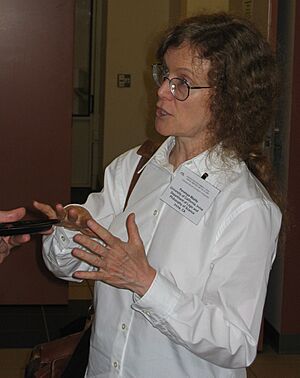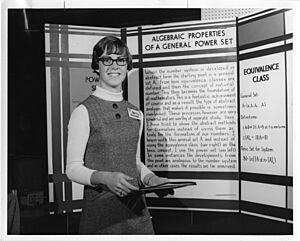Penelope Maddy facts for kids
Quick facts for kids
Penelope Maddy
|
|
|---|---|

Maddy in 2004
|
|
| Born | July 4, 1950 |
| Education | Princeton University (PhD, 1979) |
| Era | Contemporary philosophy |
| Region | Western philosophy |
| School | Analytic philosophy |
| Institutions | University of California, Irvine |
| Thesis | Set Theoretical Realism (1979) |
| Doctoral advisor | John P. Burgess |
|
Main interests
|
Philosophy of mathematics |
|
Notable ideas
|
Set-theoretic realism (also known as naturalized Platonism), mathematical naturalism |
Penelope Maddy, born on July 4, 1950, is an American philosopher. She is a highly respected professor who taught Logic, Philosophy of Science, and Mathematics at the University of California, Irvine. She is famous for her important ideas in the philosophy of mathematics, which is about understanding the nature of math. Her work includes ideas like mathematical realism and mathematical naturalism.
Contents
Penelope Maddy's Early Life and Education
Penelope Maddy first became interested in mathematics during her first algebra class in middle school. Her teacher gave her a book about abstract algebra, which is a more advanced type of math. This sparked her interest even more.
In 1968, she entered the Westinghouse Science Talent Search, a competition for young scientists. She became a finalist and placed seventh overall, which was a great achievement! After high school, she went on to study mathematics at the University of California, Berkeley. She earned her bachelor's degree in 1972.
From Math to Philosophy
Maddy became very interested in a math problem called the continuum hypothesis. She learned about it in high school. This problem was special because it couldn't be proven without adding a new basic rule, called an axiom. This made her wonder how mathematicians decide which new rules to accept.
This question led her from mathematics to philosophy. She decided to get her PhD in philosophy at Princeton University. She finished her degree in 1979. Her main project, called a dissertation, was titled Set Theoretical Realism. It was guided by her professor, John P. Burgess.
Penelope Maddy's Teaching Career
After getting her PhD, Maddy taught at the University of Notre Dame and the University of Illinois, Chicago. In 1987, she joined the University of California, Irvine. There, she held important positions. She was the head of the philosophy department. Later, she helped start and became the first head of the department of logic and philosophy of science.
She was recognized for her excellent work. In 2002, she was named Chancellor's Professor. In 2007, she became a Distinguished Professor. She retired from teaching in 2020 and is now a Distinguished Professor Emerita.
Awards and Recognition
Penelope Maddy has received many honors for her contributions to philosophy.
- In 1998, she was chosen as a Fellow of the American Academy of Arts and Sciences.
- She won the 2002 Lakatos Award for her book Naturalism in Mathematics, which was published in 1997. This award is given for outstanding work in the philosophy of science.
- The German Mathematical Society gave her a Gauss Lectureship in 2006.
- She was the president of the Association for Symbolic Logic from 2007 to 2009. During this time, she helped launch a new journal called Review of Symbolic Logic.
- From 2019 to 2020, she was the president of the Pacific division of the American Philosophical Association.
Penelope Maddy's Philosophical Ideas
Maddy's early work, especially in her book Realism in Mathematics, explored ideas about how we understand mathematical concepts. She looked at Kurt Gödel's view that mathematics describes a real world that exists independently of our minds. Gödel believed we could understand this world through our intuition.
However, Maddy suggested that some mathematical things might be concrete, meaning they exist in a physical way. This was different from Gödel, who thought all mathematical objects were abstract. She proposed that sets, which are collections of things, could have physical effects. For example, when you see three cups on a table, you also see the set of those three cups. She used ideas from cognitive science and psychology to support this. She pointed out that just as children learn to see objects instead of just colors and shapes, they also learn to see sets of objects.
Naturalism in Mathematics
In the 1990s, Maddy's ideas changed, leading to her book Naturalism in Mathematics. Her "naturalist" view suggests that science is our best way to learn about the world. So, philosophers should use scientific methods when they study science. As Maddy explained, if you are a "naturalist," you believe that science should not be judged by rules that come from outside of science itself.
However, Maddy's view is different from some other naturalists. She sees mathematics as separate from other sciences. This means that mathematics follows its own rules and goals. It doesn't need to be supported or challenged by the needs of other sciences. This idea suggests that some traditional philosophical questions about mathematics might not be the right questions to ask. Like the philosopher Wittgenstein, she thought that some puzzles come from using language in ways it wasn't meant to be used.
Maddy has also focused on understanding how set theorists agree on new axioms, especially those that go beyond the standard ZFC axioms.
Selected Books by Penelope Maddy
- Realism in Mathematics, published by Oxford University Press, 1990.
- Naturalism in Mathematics, published by Oxford University Press, 1997.
- Second Philosophy, published by Oxford University Press, 2007.
- Defending the Axioms, published by Oxford University Press, 2011.
- The Logical Must, published by Oxford University Press, 2014.
- What do Philosophers Do? Skepticism and the Practice of Philosophy, published by Oxford University Press, 2017.
- A Plea for Natural Philosophy and Other Essays, published by Oxford University Press, 2022.
See also
 In Spanish: Penelope Maddy para niños
In Spanish: Penelope Maddy para niños
- Cabal (set theory)


